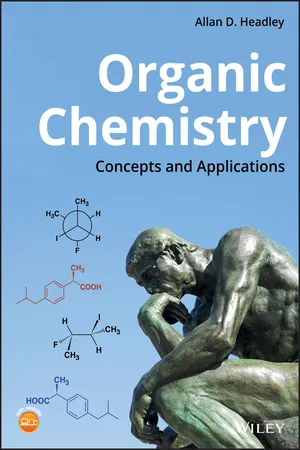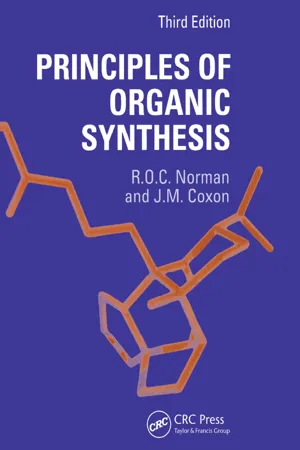Chemistry
Nitration of Alkanes
Nitration of alkanes is a chemical reaction that involves the substitution of a hydrogen atom in an alkane with a nitro group. This reaction is typically carried out using a mixture of nitric acid and sulfuric acid as the nitrating agent. The resulting nitroalkane can be used as a precursor for the synthesis of various organic compounds.
Written by Perlego with AI-assistance
Related key terms
Related key terms
1 of 4
Related key terms
1 of 3
4 Key excerpts on "Nitration of Alkanes"
- eBook - ePub
- Harold A. Wittcoff, Bryan G. Reuben, Jeffery S. Plotkin(Authors)
- 2012(Publication Date)
- Wiley(Publisher)
Chapter 13 Chemicals from AlkanesAlkanes occur as such in natural gas and petroleum, and accordingly are the cheapest raw materials for chemicals. They are the feedstocks for cracking (Sections 4.5 and 4.6) and catalytic reforming (Section 4.8). Methane is the main source for synthesis gas (Section 12.4.1) via steam reforming. The higher alkanes can be subjected to the same process if desired, or the steam reforming process can be redirected to give methane. An important process is pyrolysis of hydrocarbons to carbon black, which is discussed at the end of this chapter.Apart from pyrolysis, these reactions are endothermic and accompanied by an increase of entropy. They are all unselective and take place at high temperatures. There are few long-established examples of alkane functionalization, that is, of the use of alkanes directly for downstream chemicals. The most important are the conversion of n -butane to maleic anhydride (Section 7.4.2), the oxidation of n -butane or naphtha to acetic acid (Section 12.5.2.2), the oxidation of isobutane to t -butylhydroperoxide (Section 6.8), the oxidation of ethylbenzene to ethylbenzene hydroperoxide (Section 6.8), and the chlorination of methane (Section 12.2). Lesser volume uses involve ammoxidation of methane to hydrocyanic acid (Section 12.1), conversion of methane to acetylene (Section 12.3), and nitration of propane. These have largely been discussed.Any alkane may be nitrated. In practice only propane is used as feed, and from its nitration result nitromethane, nitroethane, and 1- and 2-nitropropane. The nitration takes place at 420°C, and the products are separated by distillation. They are used as additives for gasoline for racing cars, as solvents especially for polycyanoacrylates, and as stabilizers of chlorinated solvents. DuPont developed a process for the nitration of cyclohexane to nitrocyclohexane as a step in a caprolactam synthesis (Section 9.2.2) but it is not currently used. - eBook - ePub
- Dmitry Yu. Murzin(Author)
- 2015(Publication Date)
- De Gruyter(Publisher)
Chapter 14Key reactions in the synthesis of intermediates: nitration, sulfation, sulfonation, alkali fusion, ketone, and aldehyde condensation
14.1 Nitration
Nitration is defined as a substitution of one or several hydrogen atoms by a nitro group. As a nitration agent, typically, nitric acid or products of its transformations can be used. This reaction contrary to sulfation discussed also in this chapter is irreversible. As a nitration agent, nitric acid is often combined with concentrated sulfuric acid and water due to a fact that this mixture is not that aggressive from the corrosion viewpoint. One of the typically used compositions contains 20% of nitric acid, 60% of sulfuric acid with water being the rest. Stronger acid concentration would lead to oxidative side reactions. The active agent is thus nitronium cation formed according to(14.1)which in fact is a combination of many equilibria. The amount of nitration agent is often close to the stoichiometric ratio required for nitration. In nitration, a careful temperature control should be done, since the reaction is exothermal. Thus, mononitration of benzene(14.2)has the reaction enthalpy is −117 kJ/mol, while for naphthalene, it is even higher (−209 kJ/mol). Heat also evolves when water formed in the nitration reaction dilutes sulfuric acid.Temperature increase would be typically seen as an increase in the formation of NOx . Moreover, higher temperature results in decreased formation of the nitronium ion.Strict requirements in terms of heat management call for a careful temperature control, achieved by intensive mixing and a slow addition of reactants. A necessity of mixing stems also from the fact that the nitrating agent in an aqueous phase, while the reactant and the product form a separate organic phase. It has been argued therefore that the reaction in industrial conditions is controlled by mass transfer rather than kinetics. In particular, for nitration of aromatic compounds, it was shown that the reaction occurs mainly in the aqueous layer, while the rate is much slower in the organic phase. It should not be forgotten either that some polynitrocompounds (e.g., trinitrotoluene, TNT) are highly explosive. - eBook - ePub
Organic Chemistry
Concepts and Applications
- Allan D. Headley(Author)
- 2019(Publication Date)
- Wiley(Publisher)
Alkanes are fairly inert compounds; some alkanes are used as solvents to provide inert media for different reactions that we will see in later chapters. In addition to combustion, alkanes undergo another type of reaction that is very important to organic chemists, and that is the reaction with halogens, specifically chlorine or bromine in the presence of energy in the form of heat or light. As the name suggests, this reaction involves the reaction of alkanes and bromine or chlorine and is called bromination or chlorination of alkanes, respectively. These reactions are performed in the presence of light or heat and are described as substitution reactions since a hydrogen or more than one hydrogen atoms of an alkane reactant are substituted for a halogen or more than one halogen in the product. Most of the reactions that will be encountered in this chapter involve the substitution of one hydrogen in the alkane for a halogen in the product.The products produced upon the chlorination of alkanes are alkyl halides, most are important industrial raw material for the synthesis of numerous other chemicals. For example, chloromethane was used once as a refrigerant, but discontinued owing to its flammability and toxicity. Today, it is widely used as a chemical intermediate for the production of different compounds, including polymers. Other chloroalkanes are widely used as a solvent in the research labs and in the production of rubber and in the petroleum refining industry. The chlorination of methane is shown in Reaction (14‐5) .(14‐5)To be able to predict the products of these and other similar reactions, a thorough understanding of how the reaction occurs is essential. Before we examine the reaction mechanism for the chlorination of alkanes, let us examine the process of bond reorganization for the reaction shown in Reaction (14‐5) . It should be obvious that this reaction is a substitution reaction in which a Cl─Cl bond has to be broken and the chlorine atoms form two new bonds, a new H─Cl bond and a new C─Cl bond in the CH3 - eBook - ePub
- Richard O.C. Norman(Author)
- 2017(Publication Date)
- Routledge(Publisher)
section 13.4 ).(a) NitrosationThe nitroso group may be introduced in one of two ways. First, unsaturated carbon which is strongly activated towards electrophiles, such as that in an enol, reacts with nitrous acid or an organic nitrite in an acid-catalyzed process; the electrophile is thought to be the nitrosonium ion, NO+ :If the product has a hydrogen atom attached to the nitroso-bearing carbon, it tautomerizes to the more stable oxime: For example, acetoacetic ester, when treated in acetic acid solution with aqueous sodium nitrite, gives the oximino-derivative:Compounds which are not significantly enolic but are capable of enolization also react, for the enolization is catalyzed by acid. For example, butanone reacts with ethyl nitrite* and hydrochloric acid to give biacetyl monoxime in about 70% yield [2]; note that reaction occurs at the methylene and not the methyl group since the corresponding enol is formed the more readily of the two (cf. p. 257 ).Likewise, nitromethane gives methyl nitrolic acid via its tautomer:In the second method a compound containing a C—H group adjacent to one or more groups of −M type is treated with base (usually ethoxide ion in ethanol) in the presence of an alkyl nitrite. An enolate is generated and reacts with the nitrite in a manner analogous to the Claisen condensation (p. 226 ):If the product contains a hydrogen atom on the nitroso-bearing carbon, its acidity is such that it is converted essentially completely into its (delocalized) conjugate base (cf. the synthesis of β-keto-esters, p. 226
Index pages curate the most relevant extracts from our library of academic textbooks. They’ve been created using an in-house natural language model (NLM), each adding context and meaning to key research topics.
Explore more topic indexes
Explore more topic indexes
1 of 6
Explore more topic indexes
1 of 4



